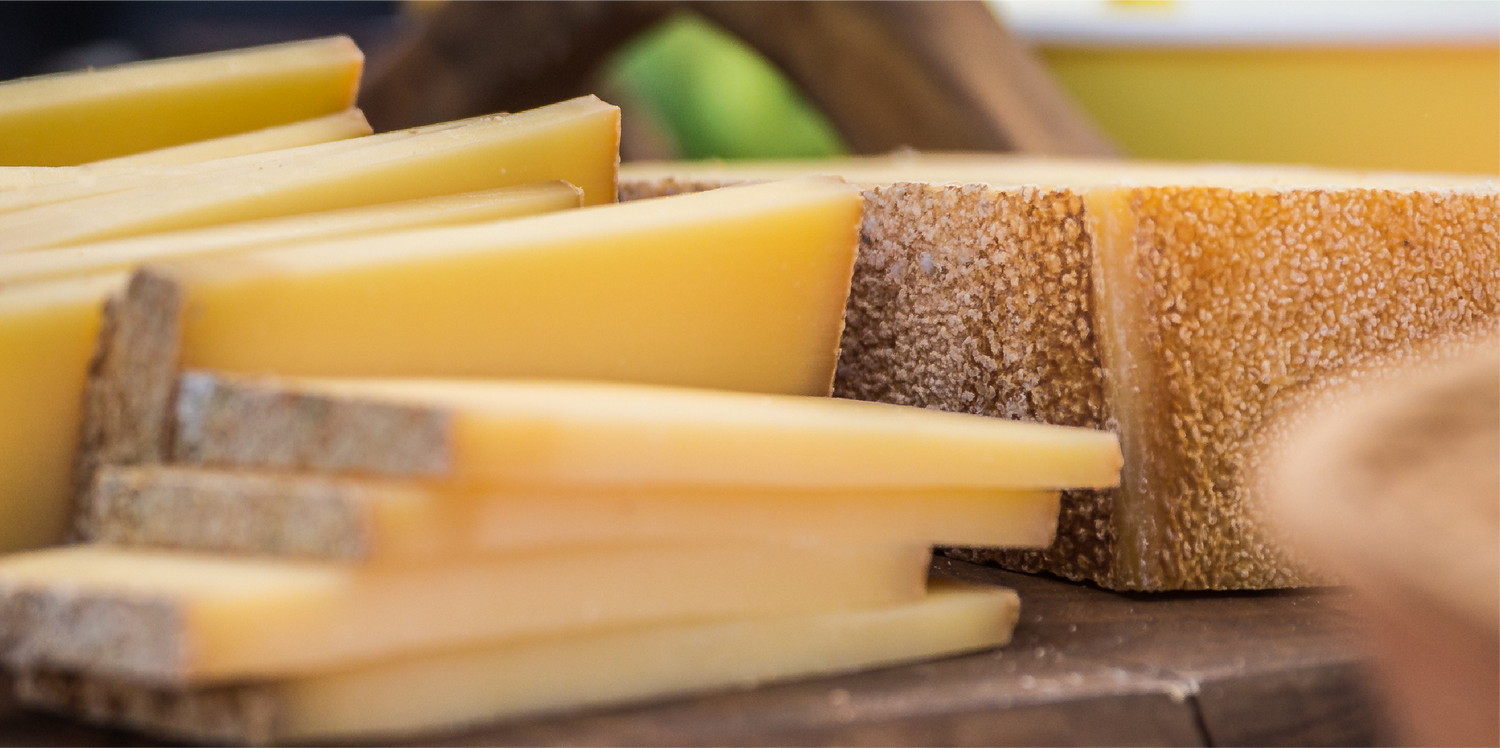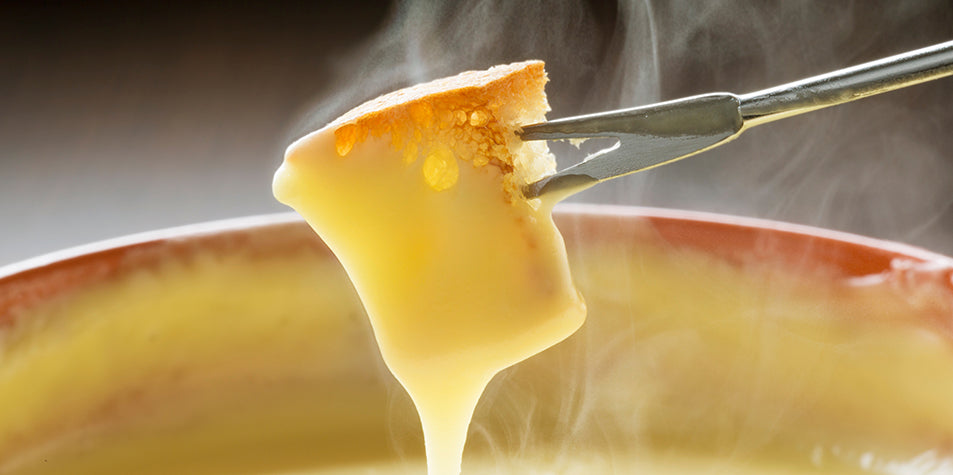Why is Comte our top selling cheese?
What is Comte Cheese?
Comte is not just a cheese; it’s a testament to centuries-old traditions, an emblem of the Franche-Comté region in eastern France, and a sensory journey that traverses lush pastures, tranquil mountain cellars, and the skilled hands of local cheesemakers. Each wheel of Comté tells a story – a story of heritage, craftsmanship, and an unparalleled passion for quality.

Quick Facts About Comté Cheese

Origin: Comte is a French cheese produced exclusively in the Franche-Comté region.
- Milk Source: Made from unpasteurized cow’s milk.
- Texture: Firm and supple.
- Flavor: Complex, nutty, and slightly sweet.
- Color: Pale yellow.
- Aging Process: Typically aged for 8 to 36 months.
What Makes Comte Special?
- Region-Specific Production: Comte’s unique flavor cannot be replicated elsewhere. It’s exclusively crafted in the Franche-Comté region, where lush pastures and traditional methods contribute to its distinct taste.
- Traditional Methods: Each wheel of Comte is handmade by skilled cheesemakers. Raw milk from Montbéliarde cows grazes on natural pastures, infusing the cheese with character.
- AOC Protected: Comte holds AOC (Appellation d’Origine Contrôlée) and PDO (Protected Designation of Origin) status. Every aspect of production, from cow breed to aging, is strictly regulated for authenticity and quality.
- Flavor Complexity: Comte’s flavor profile dances between fruit, nuts, caramel, and even chocolate. Factors like cow diet, production season, and aging influence its taste.
Pairing and Uses
- Ideal for Snacking: Slice Comte and enjoy it with crusty bread or fresh fruit.
- Grating: Sprinkle grated Comte over pasta, risotto, or salads.
- Melting: Melt Comte into traditional French dishes like Croque-Monsieur or gratins.
What is a good substitute for Comte Cheese?
Remember that each cheese brings its unique character to the table. When seeking a substitute for Comte cheese we recommend using Gruyere. Gruyere is the best substitute as it is also made from cow’s milk and has a similar aging process. It has a buttery and hazelnut flavor that melts well and tastes great in fondue and baked dishes.
How do you pronounce Comte?
The French word “Comte” is pronounced as “kawnt”. It rhymes with the English word “count” and is used to refer to a type of French cheese made from unpasteurized cow’s milk. You can also watch some videos that demonstrate how to pronounce Comte:
How to pronounce Comté cheese?

What does Comte Cheese taste like?
Comte is known for its distinct flavor profile. It is often described as having a nutty and slightly sweet flavor. The taste can be described as creamy and fruity with hints of grass and hay, reflecting the natural diet of the cows whose milk is used to produce the cheese.
The flavor and texture of Comte cheese can vary depending on the season, the age, and the region where it is produced. Comte cheese can be aged from 4 months to 2 years. When aged, its flavor is nutty, smoky, fruity, and sweet, while the younger cheeses are more milky and fresh tasting. As the cheese matures, it develops deeper flavors. The flavor can also vary depending on the season, as the diet of the cows changes between summer and winter.
Here are its flavors and characteristics:
- Young Comte:
- A pale yellow color with an open, supple, and grainy texture.
- Fresh and milky taste, akin to butter and cream.
- Hints of grass and hay, reflecting the natural diet of the cows.
- Aged Comte:
- As it matures, the flavor deepens.
- Nutty, smoky, fruity, and sweet notes.
- The texture becomes denser, firm, and sometimes crystalline.
- Some describe it as having a creamy, fruity taste with grassy undertones.
- The Process:
- Comte cheese undergoes a meticulous process, from raising and feeding the cows to aging.
- The milk comes from specific breeds (Montbéliardes and French Simmental) raised in the Jura Massif region.
- The cows graze on diverse pastures, contributing to the richness of flavor and aroma.
- The cheese is aged for 4 to 24 months, resulting in spicy, nutty flavors.
So, imagine a cheese that evolves from fresh and milky to complex and nutty—a true delight for cheese enthusiasts!
What is the best way to cut Comte cheese?
The art of cutting comte: how you cut your comte can enhance your tasting experience. Comte cheese is a hard cheese that is usually cut into thin slices or wedges. There are different ways to cut Comte cheese depending on the size and shape of the piece:
- For large pieces, use a cheese wire or a two-handled knife to cut the cheese in quarters.
- Then, cut each quarter into smaller wedges, following the natural shape of the cheese and the rind.
- Cut each wedge into thin slices, starting from the tip and ending at the rind.
- Alternatively, you can cut each wedge into small cubes or chunks, depending on your preference and the purpose of the cheese.
The main idea is to cut the cheese in a way that preserves its flavor and texture, and that gives each piece a bit of rind. You can eat even the heel of Comte cheese, as it is all edible and delicious.

What kind of cheese is Comte?
Comte is a French cow’s milk cheese made from unpasteurized milk. It hails from the Jura Massif region in eastern France. It’s known as a “mountain cheese,” due to its origin in the mountains near the border with Switzerland. It is a semi-hard cheese with a nutty, smoky, fruity and sweet flavor and a creamy texture that ranges from supple to firm. It is one of France’s most popular cheeses and has a Protected Designation of Origin status.
So, whether you’re melting it over a gratin or savoring it on a cheese platter, Comte brings a taste of the French mountains to your plate!
What foods pair well with Comte?
Comte cheese is a versatile cheese. You can eat it on its own or on a cheese board with crusty bread, Capella Cheese crackers, quince paste, almonds or honey, or pair it with wine, beer, or cider. You can also use it for cooking, as it melts well and adds flavor to dishes like gratins, soufflés, quiches, salads, sandwiches, and sauces. You can also make a cheese tart with Comte cheese and wild garlic, a cheese loaf with Comte cheese and sun-dried tomatoes, or a sandwich with Comte cheese and nduja or other hand-crafted salami.
Capella’s Rare Comte Collection
We offer a rare collection of Comte from our cheese shop: a vertical tasting of 5 ages of Comte. All of these cheeses are from 5th generation cheese affineur Marcel Petit, and aged at Ft. St Antoine in the Jura Mountains of France. These Comtes are crafted within 50 kilometers of the for they are aged, and the aging occurs under the watchful eyes of highly trained cellar masters. These special Comtes are hand-selected to meet a consistent and exquisite flavor profile, including strong notes of browned butter, nutty, rich mountain herbs.





Leave a comment
This site is protected by reCAPTCHA and the Google Privacy Policy and Terms of Service apply.